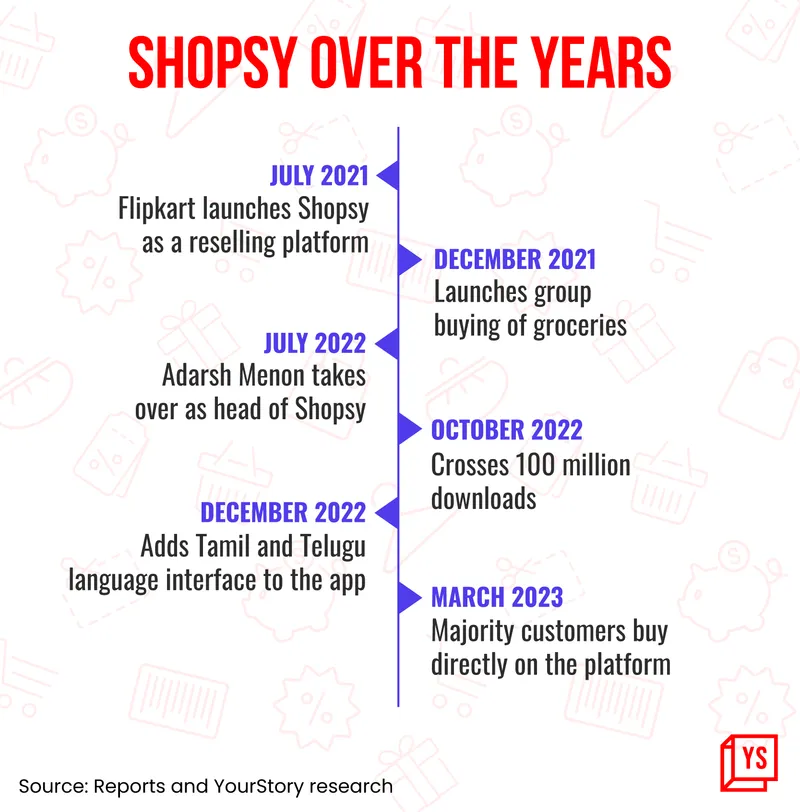Flipkart’s Shopsy still seeking the right hook to reel in shoppers
Nearly two years since launch, and with Reliance's JioMart, Amazon-owned GlowRoad and Shop101 snapping at its tail, Shopsy has tried several tricks in the book to convert fence-sitters to loyal customers.
When Walmart-backed launched nearly two years ago, the idea was to target shoppers in Tier II cities and beyond, and—more importantly—build a formidable rival to social commerce firm Meesho that was threatening to encroach into its territory.
Shopsy started out as a social commerce platform where resellers from smaller cities could order for their network of friends and family and earn a commission, similar to Meesho's re-seller model.
Social commerce represents huge opportunities for entrepreneurs. By some estimates, India's social commerce market is expected to grow steadily at a compounded annual growth rate (CAGR) of 23.8% between 2022 to 2028. The gross merchandise value (GMV, or the total value of goods sold on an ecommerce platform over a particular period) is expected to touch $19.83 billion in 2028 from $5.49 billion in 2023, says a report by Research and Markets.
But two years in, Shopsy has strayed away from the reseller model and is focussed on driving direct purchases from consumers to grow the platform—similar to its parent Flipkart, and a model Meesho too has embraced.
Shopsy has attempted multiple iterations along the way, besides changing leadership, with Adarsh Menon taking over as its head in July last year.
The Flipkart subsidiary now wants to reach an estimated 300 million-plus customers who are starting out on ecommerce. With SoftBank and Facebook-backed Meesho emerging as the number three player in India’s ecommerce race, behind Flipkart and Amazon, Shopsy is Flipkart’s gamble to create a differentiation in the non-urban market.
Reaching the next 300 million
The Shopsy app, which has over 150 million downloads on Google Play Store, continues to draw a large number of new-to-ecommerce customers.
“The Shopsy customer is broadly of two types–one who is not on any ecommerce platform, and one who is an infrequent ecommerce shopper,” Adarsh Menon, Senior Vice President and Head, New Businesses (Shopsy, Cleartrip, ReCommerce) at Flipkart, told YourStory.
“If I look at the Shopsy customer base for the last year, nearly 160 million people installed the app last year. Approximately 40% were new to ecommerce, which is a number as big as nearly 64 million,” said Menon, adding that the market size was spread across nearly 300 million customers in India, including 200 million first-time shoppers and 100 million fence-sitters on ecommerce. Menon describes fence-sitters as shoppers who buy products and services online, though infrequently.
Shopsy crossed the 100 million-user mark in mid-2022, with 60% of its users coming from Tier III regions and beyond, and about 15% from large metro cities.
Meesho had nearly 125 million Monthly Active Users on its app as of August 2022, according to media reports.

A timeline of changes at Shopsy
To offer competitive pricing, Shopsy relies on technology provided by Flipkart and the supply chain capabilities of Ekart—Flipkart’s in-house logistics service. The cost-benefit from automation and partnering with in-house technology is passed on to Shopsy’s customers and sellers, offering them a “hyper value proposition.”
Shopsy has also automated the customer experience backend to reduce costs, and uses Flipkart’s AI model for address completion to reduce chances of non-delivery.
“There are 15-20 initiatives that Shopsy and Flipkart work on together to reduce the cost of the supply chain for Shopsy,” said Menon. "And all the cost that is stripped out of the system, goes to the seller and customer to maintain the hyper-value proposition."
As part of its synergy with Flipkart, Shopsy listed all the sellers on Flipkart automatically on its platform as it began operations. Menon calls it a form of investment into building Shopsy.
The platform has 1.1 million sellers in total including those who also sell on Flipkart, though the company did not share the number of sellers unique to Shopsy. In comparison, Flipkart’s seller base was close to 11 million, according to the latest reports. Meesho reported a seller base of 0.77 million sellers around September 2022.
The average selling price on Shopsy is Rs 210-Rs 220, with nearly 100,000 active seller transactions per month. To incentivise sellers, Shopsy started out as a zero-commission platform.
The goalpost, however, keeps changing, said a seller of women’s ethnic wear on Shopsy.
“We were told our listings will be mapped to Shopsy automatically at the time of the launch. But later, we had to relist onto the platform. It started with zero commission and zero charges but later Shopsy started charging for logistics and other fees, while Meesho doesn’t charge any logistics or fee from sellers,” Deepesh Parswani, CEO of women’s wear brand Banjara India, told YourStory.
"As a seller, we have very little time to keep up with ad-hoc changes. It will be easier if the platform were to change the costing periodically," Parswani added.
Shopsy does not charge customers for shipping, though.
Parswani also said that while Shopsy was similar to Meesho, it can't be regarded as a ‘Meesho-killer’ due to its lack of transparency in policy and its smaller reseller base.
Taking the long way
Given the low-ticket size and value-conscious customer base, returns from shoppers are a problem on ecommerce platforms, added Parswani. “We prefer to sell high-value items through our brand website rather than on any ecommerce marketplace.”
For Shopsy, too, the percentage of returns is high, corresponding to the high percentage of cash-on-delivery orders. This is a risk the platform is willing to take in order to lock in customers.
Returns from customers, though, drive up logistics costs as this is a multi-step process involving pick-up from the customer, and ensuring the right product is returned, as well as the reverse logistics cost and refunds involved.
According to a 2022 report by PGA Labs titled India Ecommerce Logistics Industry, the return rate for overall ecommerce retail in India was estimated to be 18%-25%.
“Today, 70-75% of orders are cash-on-delivery, but these numbers were even higher six months ago,” said Menon. “As customers become more comfortable with the platform, the number of pre-paid orders will go up and RTOs (return to origin) will go down. We are not unduly worried about it but we would like the returns to come down.”
Shopsy sells nearly 200 million products across 800 categories to a predominantly female customer base. The platform says 65%-70% of its customers are women, with its top-selling categories being women’s apparel, ethnic wear, jewellery, and make-up.
The platform had dabbled in grocery delivery in December 2021, launching the service across 700-plus cities through a group-buying model. This draws a parallel with Meesho’s foray into grocery with Farmiso. Neither of these experiments seems to have worked.
Monetising its long tail of value-conscious customers will continue to pose a challenge to Shopsy as it tries to fight off incumbents including Reliance Group's JioMart, Amazon-owned GlowRoad, Meesho and Shop101.
Menon says Flipkart isn't bothered about the competition as much as it wants to be a serious contender to capture the audience base.
“Given the size of the market, 100% efforts should be focused on the customer base and not the competition,” Menon said. "This is a market everyone can survive in and do well."
(Cover image by Chetan Singh and infographics by Winona Laisram)
Edited by Akanksha Sarma







